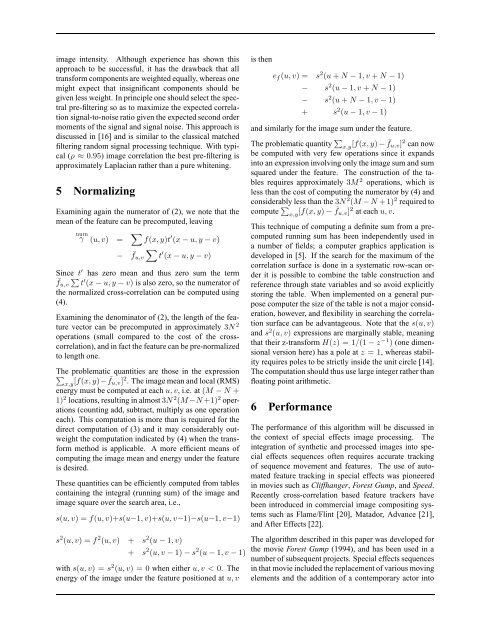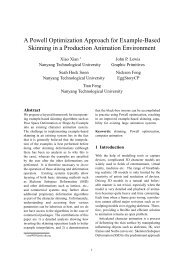Fast Normalized Cross-Correlation - JP Lewis
Fast Normalized Cross-Correlation - JP Lewis
Fast Normalized Cross-Correlation - JP Lewis
Create successful ePaper yourself
Turn your PDF publications into a flip-book with our unique Google optimized e-Paper software.
image intensity. Although experience has shown this<br />
approach to be successful, it has the drawback that all<br />
transform components are weighted equally, whereas one<br />
might expect that insignificant components should be<br />
given less weight. In principle one should select the spectral<br />
pre-filtering so as to maximize the expected correlation<br />
signal-to-noise ratio given the expected second order<br />
moments of the signal and signal noise. This approach is<br />
discussed in [16] and is similar to the classical matched<br />
filtering random signal processing technique. With typical<br />
(ρ ≈ 0.95) image correlation the best pre-filtering is<br />
approximately Laplacian rather than a pure whitening.<br />
5 Normalizing<br />
Examining again the numerator of (2), we note that the<br />
mean of the feature can be precomputed, leaving<br />
num<br />
γ (u, v) = � f(x, y)t ′ (x − u, y − v)<br />
− ¯ �<br />
′<br />
fu,v t (x − u, y − v)<br />
Since t ′ �<br />
has zero mean and thus zero sum the term<br />
¯fu,v<br />
′ t (x − u, y − v) is also zero, so the numerator of<br />
the normalized cross-correlation can be computed using<br />
(4).<br />
Examining the denominator of (2), the length of the feature<br />
vector can be precomputed in approximately 3N 2<br />
operations (small compared to the cost of the crosscorrelation),<br />
and in fact the feature can be pre-normalized<br />
to length one.<br />
The problematic quantities are those in the expression<br />
�<br />
x,y [f(x, y)− ¯ fu,v] 2 . The image mean and local (RMS)<br />
energy must be computed at each u, v, i.e. at (M − N +<br />
1) 2 locations, resulting in almost 3N 2 (M −N +1) 2 operations<br />
(counting add, subtract, multiply as one operation<br />
each). This computation is more than is required for the<br />
direct computation of (3) and it may considerably outweight<br />
the computation indicated by (4) when the transform<br />
method is applicable. A more efficient means of<br />
computing the image mean and energy under the feature<br />
is desired.<br />
These quantities can be efficiently computed from tables<br />
containing the integral (running sum) of the image and<br />
image square over the search area, i.e.,<br />
s(u, v) = f(u, v)+s(u−1, v)+s(u, v−1)−s(u−1, v−1)<br />
s 2 (u, v) = f 2 (u, v) + s 2 (u − 1, v)<br />
+ s 2 (u, v − 1) − s 2 (u − 1, v − 1)<br />
with s(u, v) = s 2 (u, v) = 0 when either u, v < 0. The<br />
energy of the image under the feature positioned at u, v<br />
is then<br />
ef (u, v) = s 2 (u + N − 1, v + N − 1)<br />
− s 2 (u − 1, v + N − 1)<br />
− s 2 (u + N − 1, v − 1)<br />
+ s 2 (u − 1, v − 1)<br />
and similarly for the image sum under the feature.<br />
The problematic quantity �<br />
x,y [f(x, y) − ¯ fu,v] 2 can now<br />
be computed with very few operations since it expands<br />
into an expression involving only the image sum and sum<br />
squared under the feature. The construction of the tables<br />
requires approximately 3M 2 operations, which is<br />
less than the cost of computing the numerator by (4) and<br />
considerably less than the 3N 2 (M − N + 1) 2 required to<br />
compute �<br />
x,y [f(x, y) − ¯ fu,v] 2 at each u, v.<br />
This technique of computing a definite sum from a precomputed<br />
running sum has been independently used in<br />
a number of fields; a computer graphics application is<br />
developed in [5]. If the search for the maximum of the<br />
correlation surface is done in a systematic row-scan order<br />
it is possible to combine the table construction and<br />
reference through state variables and so avoid explicitly<br />
storing the table. When implemented on a general purpose<br />
computer the size of the table is not a major consideration,<br />
however, and flexibility in searching the correlation<br />
surface can be advantageous. Note that the s(u, v)<br />
and s 2 (u, v) expressions are marginally stable, meaning<br />
that their z-transform H(z) = 1/(1 − z −1 ) (one dimensional<br />
version here) has a pole at z = 1, whereas stability<br />
requires poles to be strictly inside the unit circle [14].<br />
The computation should thus use large integer rather than<br />
floating point arithmetic.<br />
6 Performance<br />
The performance of this algorithm will be discussed in<br />
the context of special effects image processing. The<br />
integration of synthetic and processed images into special<br />
effects sequences often requires accurate tracking<br />
of sequence movement and features. The use of automated<br />
feature tracking in special effects was pioneered<br />
in movies such as Cliffhanger, Forest Gump, and Speed.<br />
Recently cross-correlation based feature trackers have<br />
been introduced in commercial image compositing systems<br />
such as Flame/Flint [20], Matador, Advance [21],<br />
and After Effects [22].<br />
The algorithm described in this paper was developed for<br />
the movie Forest Gump (1994), and has been used in a<br />
number of subsequent projects. Special effects sequences<br />
in that movie included the replacement of various moving<br />
elements and the addition of a contemporary actor into







